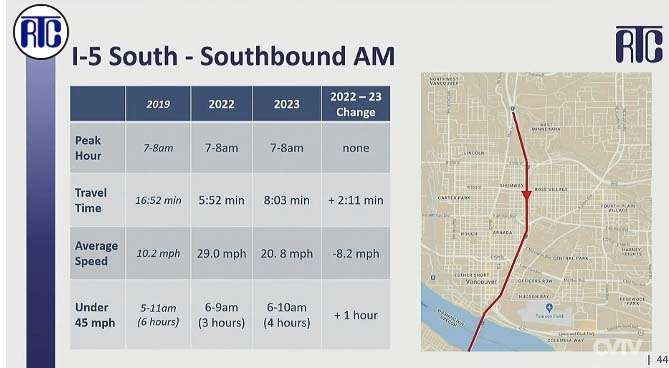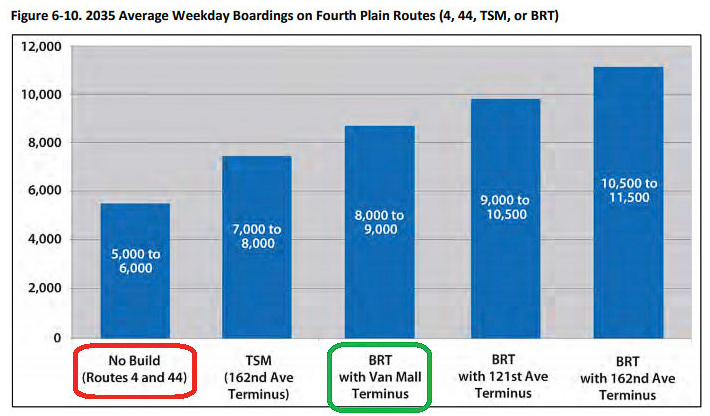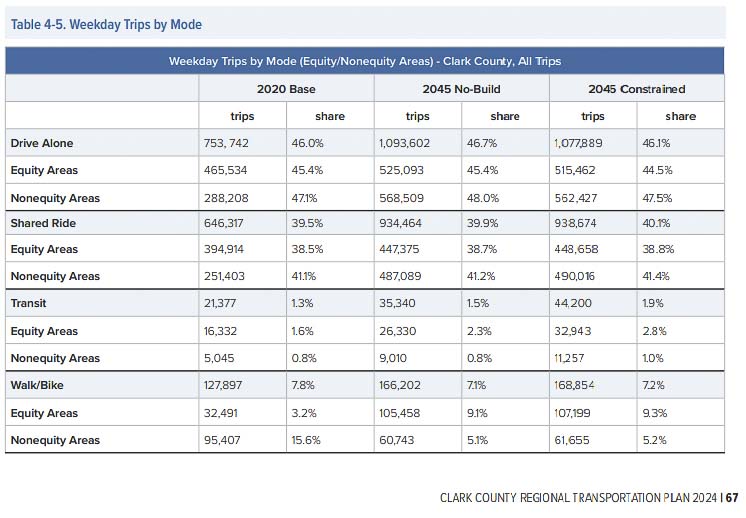Cross-river transit ridership almost flat as more people work from home
John Ley
for Clark County Today
Members of the Southwest Washington Regional Transportation Council (RTC) Board were told there is a “new normal” in how people travel to work after the pandemic lockdowns. Transit ridership is down 68 percent, biking is up 10 percent, and working from home is up 150 percent. Both interstate and arterial traffic have almost returned to pre pandemic levels, reported Principal Planner Mark Harrington.
“Pre pandemic levels will not provide us a good baseline,” Harrington said. “Clark County’s population has grown by 39,000 people since 2019, and is comparable to adding Ridgefield and Battle Ground to the county,” he said. Fully, 75 percent of people work in the county, up from 70 percent. People working outside of Washington dropped by 23.6 percent.
“A growing community needs a diversity of options,” stated RTC Director Matt Ransom. He said we shouldn’t immediately look to expand freeways, but instead should look to TMSO (transportation management systems) and other options. “Don’t run first to widen the roadway because you have a little congestion,” he told the Board, mentioning all the investments in transit and signaling devices currently being added.
RTC Director Matt Ransom tells Board members we should not immediately look to expand freeways, when dealing with congestion. He emphasized that a growing community needs a diversity of options. Video courtesy Regional Transportation Council
Vancouver’s Erik Paulsen prefers “congestion management” over “congestion reduction.” He noted the growing population is only going to add to congestion problems.
RTC Board Chairman Jack Burkman noted that “some people hoped work from home would solve our congestion problems.” That hasn’t happened. “Our congestion is back,” he said. “We’ll look for more solutions.”
It’s been over 40 years since new vehicle capacity has been added to the region. That is the one solution being avoided because officials, especially in Portland, refuse to add vehicle capacity to area freeways. The Interstate Bridge Replacement Program (IBR) is not adding new through lanes to the $7.5 billion project.
C-TRAN CEO Leann Caver told the RTC Board that local transit ridership is above pre pandemic levels. “Commuter ridership (across the Columbia River) is not showing any increase,” she said.
C-TRAN officials recently shared ridership numbers with Clark County Today, including a two-person increase in daily I-5 express bus ridership into Portland. Ridership to Portland over I-205 increased by 22 boardings a day. There were only 908 average daily boardings on C-TRAN routes 105 and 105X, 164, and 190 express routes over the Columbia River in 2023. Overall, the agency had 4.2 million annual boardings.
This “new normal” mirrors national data showing transit ridership remains well below pre pandemic levels. Washington state was one of two states where over 20 percent of workers were home-based.

The transit ridership issue is vitally important to Clark County and Portland metro citizens because the Interstate Bridge Replacement Program (IBR) team members are telling the community that there will be between 26,000 and 33,000 daily transit boardings on the I-5 corridor in 2045. They want to spend up to $2 billion on a 3-mile extension of MAX light rail into Vancouver.
Transit ridership at both TriMet and C-TRAN were declining even before the pandemic lockdowns. They are down significantly from the 1999 peak for C-TRAN and 2012 levels for TriMet. Reason magazine reported a year ago, “Ridership is expected to recover to only 80 percent of its pre-COVID level.” They noted “agency expenses are higher than pre-COVID while farebox revenues are lower.”
Five years ago, C-TRAN offered seven “express” bus routes over the Columbia River. Today there are three. There is so little demand for cross-river transit that TriMet does not offer bus service to Clark County.
In 2019, the worst average speed on I-5 during the morning commute was 10.2 miles per hour, according to Harrington. That was measured from Main Street to the Hayden Island exit. In 2023 it was 20.8 mph, but declined over 8 mph from a year earlier. On I-205 last year, the worst average speed was 40 mph.
There were six hours (5 to 11 a.m.) in the morning commute on I-5 where traffic speed was below 45 mph in 2019. That was down to four hours (6 to 10 a.m.) of slower speeds in 2023.
The IBR is proposing to replace an over-congested, three-lane bridge with another three-lane bridge, plus one auxiliary lane. Sadly for many, this will not reduce traffic congestion on I-5 nor improve vehicle speeds. The IBR team predicts in 2045 that travel times will double from 29 to 60 minutes in the morning, southbound commute. Furthermore, half of rush hour traffic will be stuck going zero to 20 mph.
As a contrast, the RTC reported that SR-14 had average morning speeds of 23.8 mph in 2019. Two new auxiliary lanes are being added on this state highway between 164th Ave. and I-205 to reduce morning traffic congestion and improve vehicle speeds. Why won’t the IBR propose more through lanes and more than one auxiliary lane across the Columbia River, given average speeds on I-5 are even worse?
The RTC’s 2024 Regional Transportation Plan (RTP) for 2045 shows a 340,000-daily-trip increase by people driving alone, if they do nothing, and a 320,000-trip increase if they build the IBR. That’s a 42 to 45 percent increase in the number of vehicles on the road, just a decade after the $7.5 billion project is finished.
High Capacity Transit
In evaluating high capacity transit service, C-TRAN reported 2023 ridership on the Vine Bus Rapid Transit (BRT) system was 3,232 daily boardings on the Fourth Plain route, and 2,001 boardings on Mill Plain. The Vine began service in 2017, replacing two bus lines, 4 and 44. In 2014, those two routes had 6,919 daily boardings.

C-TRAN officials told the Federal Transit Administration in 2011 they served over 6,000 average weekday passengers” and forecast between 8,000 and 9,000 people served by 2035. Yet in 2019, (prior to the pandemic), average weekly boarding passengers were down by over 33 percent, to 3,989. Four years later, ridership declined an additional 19 percent.
A decade after investing roughly $50 million to create the Vine, ridership on the Fourth Plain route has dropped by 53 percent from 6,919 to 3,232 boardings. Sadly, the Mill Plain BRT route hasn’t performed any better in replacing route 37.
In 2018, route 37 had average daily boardings of 3,077, which declined to 1,911 in 2020. Today’s BRT line had 2,001 boardings, 90 more than at the beginning of the pandemic, but a 35 percent decline from ridership before the BRT line was created. It appears creating BRT service using expensive million dollar buses doesn’t stimulate demand or ridership.
In 2023, the C-TRAN Operating Revenue per Passenger was 61 cents, matching the 2022 number. In 2019, the agency took in $1.04 per passenger. In 2016, it took in $1.30 per passenger, more than double current passenger payments.
The cost per passenger mile was $2.66 in 2022, indicating $2.05 per mile of operating costs are paid by taxpayers. Revenues are less than half of what they were seven years ago, with taxpayers now picking up about 95 percent of operating costs for C-TRAN.
In 2019, C-TRAN projected significant growth on its system ridership in the 5-year Transit Development Plan. Officials were predicting 6.39 million boardings. Instead, the agency delivered 4.2 million, 34 percent less. Additionally, 2023 was 46 percent below C-TRAN’s all-time high of 7.75 million boardings in 1999. According to the RTC, this is the “new normal.”
The new normal is significantly more people working from home. Given the new normal is nearly 50 percent below all time transit ridership levels from when C-TRAN only offered service with 49-passenger buses, does it make sense to spend $50 million on new BRT service? Does it make any sense to spend $2 billion on a 3-mile MAX light rail extension?
Does it make sense to allow TriMet to charge taxpayers on both sides of the Columbia River new taxes to cover the operations and maintenance costs for that light rail? That is what TriMet (and the IBR) is demanding.
The overwhelming majority of people prefer to use their privately owned vehicles. Surveys from both the Oregon Transportation Commission, PEMCO, and the IBR indicate the people’s number one priority is to save time and reduce traffic congestion because they will use their cars.

Also read:
- Opinion: Hiding the growing cost of the Interstate Bridge replacementJoe Cortright of the City Observatory addresses the rising cost of the Interstate 5 Bridge replacement project.
- 90 minutes of delay on Southbound I-5 in Southwest Washington on Friday afternoon, July 26Travelers using southbound Interstate 5 through Woodland should expect up to 90 minutes of delay during Friday afternoon and evening and should delay travel or prepare for additional travel time.
- Nighttime paving work on I-5 and SR 14 in Clark County July 28-Aug. 9Nighttime travelers in Clark County should expect delays for maintenance and paving work beginning Sunday, July 28 until the morning of Friday, Aug. 9.
- Northeast 182nd Avenue/Northeast Ward Road to be closed on Aug. 1Northeast 182nd Avenue and Northeast 172nd Avenue in Clark County will have single-day closures on August 1 and August 5 for road preservation, with detours in place.
- Interstate Bridge Replacement program awarded $1.499 billion FHWA Bridge Investment Program grantInterstate Bridge Replacement program officials have shared that the program received $1.499 billion through the Federal Highway Administration’s Bridge Investment Program.









